| |
Warsaw
Travel Guide: Warsaw's Royal Castle
The Royal
Castle (Polish Zamek Królewski) in Warsaw is the royal palace and
official residence of the Polish monarchs. The personal offices of
the king, as well as the administrative offices of the Royal Court
of Poland were located there until the Partitions of Poland.
Between 1926 and World War II the palace was the seat of the
Polish president. It is located at the Plac Zamkowy, at the
entrance to the Old Town.
Partially destroyed by German bombers during the Invasion of
Poland, it was heavily damaged by German bombardment and artillery
fire during the Warsaw Uprising. The remnants were blown up by
German engineers in September 1944 and were not removed until
1971. Reconstructions were started in the early 1970s and in July
1974 the clock on the tower began working again, on the exact same
time at which it was stopped by the Luftwaffe bombardment.
Nowadays it
is used as a branch of the National Museum and for ceremonial
purposes. During the Siege of Warsaw in 1939 many of the works of
art from the castle were transferred to several basements around
Warsaw and hidden thus from German authorities they survived the
war and were put on exhibition in their original place. |
 |
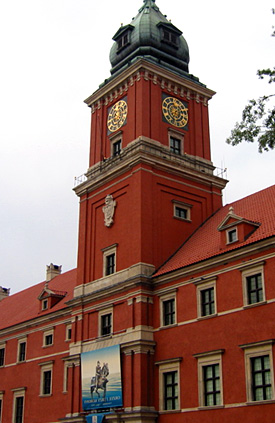 |
The interior
consists of many different rooms, all painstakingly restored with as
much original exhibits as possible after the destruction of the Second
World War.The Jagiellonian Rooms: these rooms, which belonged to the residence
of Augustus III, are now host to a number of portraits of the Jagiello
family, a royal dynasty originating in Lithuania that reigned in some
Central European countries between the 14th and 16th century.
The Houses of
Parliament: from 16th century onwards, Polish democracy started here.
In 1573, amendments to the constitution of the Polish-Lithuanian
Commonwealth were written here, with great religious tolerance. Also,
during the Deluge in 1652, the liberum veto was established in these
rooms, although not carried out until 1669. In 1791, the May
Constitution, Europe's first modern codified national constitution as
well as the second oldest national constitution in the world, was
drafted here. The decorations in the room are replica's of the
originals by Giovanni Battista di Quadro.
|
Warsaw Photo Gallery Preview |
 |
 |
 |
 |
 |
The Royal Apartments: in these apartments, king Stanisław August
Poniatowski lived. They consist of the Canaletto room, in which
several painted views of Warsaw are on display. These were not painted
by Canaletto, but rather by his nephew, Bernardo Bellotto. Jean-Baptiste
Pillement worked between 1765-1767 on one of his largest projects, the
wallpaper. Domenico Merlini designed the adjacent Royal Chapel in
1776. Nowadays, the heart of Tadeusz Kosciuszko is kept here in an
urn. The Audience Rooms are also designed by Merlini, with four
paintings by Marcello Bacciarelli on display. Andrzej Grzybowski took
care of the restoration of the room, that included many original
pieces.
Lanckoroński Collection: in 1994 Countess Karolina Lanckorońska
donated 37 pictures to the Royal Castle. Collection includes two
paintings (portraits) by Rembrandt.
Warsaw Travel Guide:
Warsaw's Royal Castle: Out of the Ashes
On January 20,
1971, a miracle happened. It was decided that the Royal Castle in
Warsaw, destroyed by the Nazis in September 1944, would be
reconstructed. It was a daring project, since the communist government
showed no interest in this kind of architecture and thus did not
donate a single gross (penny). Only in 1981 did the state start the
bear the costs of further restoration and maintenance. Despite the
problems, the walls were reconstructed as early as 1974. It took ten
more years to make the interior of the castle shine with their former
splendor.
A glimmer of
hope for the reconstruction of the castle appeared in the spring on
1947. While Trasa W-Z (the East-West highway) was being built over the
Vistula River, Jan Zachwatowicz, the general curator of the city, had
Grodzka Gate at the southern side of the castle reconstructed. This
way he wanted to prevent socialist city planners from building a road
there, which would have eliminated any hope for later reconstruction
of the whole castle. On July 2, 1949, the Polish Parliament passed a
motion to reconstruct the castle.
The decision,
however, was never translated into action due to the opposition of the
communist government. The director of the National Museum, Stanislaw
Lorentz, fought tirelessly to put the project into effect, writing
articles, till censorship finally silenced him. He sent numerous
letters to the authorities and party leaders, met with them and used a
variety of arguments, but he was banging his head against a brick
wall.
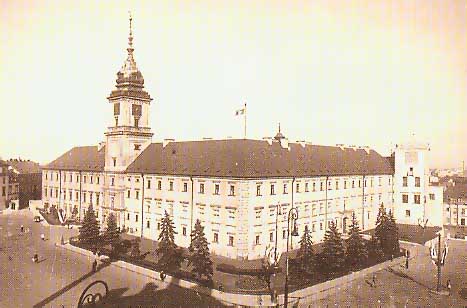
Royal Castle in the 1930's. Photo Z. Chomitowska
Twenty years
were to pass before there appeared a faction in the government, which
saw the project’s propaganda potential. Following the events of the
Gdansk shipyard, the communists wanted to divert public attention
towards national and cultural values. In mid-January 1971, Professor
Stanislaw Lorentz was invited by the Communist Party to a meeting in
the Central Committee Building. He was informed of the Politburo’s
assent to the reconstruction. The Politburo had already discussed the
issue on January 19, 1971. On January 20, 1971, a few other people
were informed and the next day the news was published in the Zycie
Warsaw daily newspaper.
Now things could
get going. On January 26, 1971, the citizens’ committee for the
reconstruction of the castle met for the first time and addressed an
appeal for help to people tin Poland and abroad and over the years
collected $800,000. The project was prepared by Studio Zamek (Castle),
a state-owned enterprise for the restoration of historical and
cultural monuments, directed by Jan Boguslawski. In the committee,
Lorentz was responsible for scientific issues. Jan Zachwatowicz for
architectural and preservation questions and Aleksander Gieysztor for
archaeological scrutiny.
In the same
year, Professor Lorentz undertook some journeys, among others to Rome,
London and six other cities in the USA in order to gain some publicity
and means for the ambitious scheme. He gave lectures and interviews,
screened films and participated in discussions. During his three-week
trip, Lorentz is said to have achieved more than the Polish attaché
did in many years.
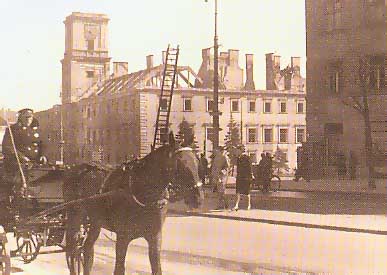
Royal Castle 1939-1944 after Nazis set fire
He emphasized
that the reconstruction of the castle was a gift from all Poles,
living both in the country and abroad, to the Polish nation. The
reconstruction works started on September 17, 1971. It took three
years to build the shell of the building. The ceremonial decoration of
the ridgepole was held on July 19, 1974, starting at exactly 11:15 am
to commemorate the moment when in 1939 the clock on the tower stopped.
On January 1, 1984, the castle was opened to visitors. The ballroom
was completed in 1988.
The first director of the newly reconstructed position was Gieysztor.
He held the position from 1980 to 1991. Since 1991, Professor Andrzej
Rottermind, Ph.D., has been in charge, the vice-minister of culture in
1991 and previously vice-director of the National Museum. The two
periods of office stand for continuity and persistence. Also, Lorentz
devoted over forty years of his life to the cause of saving the
castle. Paradoxically, he and few others started to struggle for the
castle even before it was bombed. Its destruction was decided upon
when Germany invaded. Hitler wanted to exterminate the Polish nation
and to reduce Warsaw (at that time a city of one million people) to a
provincial town with a population of 130,000.
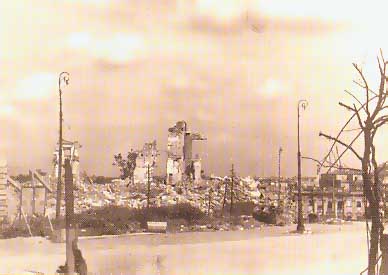
Royal Castle in ruins 1945
At the site of
the castle, the construction of a congress and cultural center was
planned. According to the outline of a team of architects from
Munster, Germany, the castle was supposed to give way to a green area.
The destruction started with a bombardment on September 17, 1939,
which the castle caught fire. In 1939-40, German forces drilled holes
for explosives in the whole building. Under cover of night, brave
people lead by Lorentz removed from the castle everything they could
carry – paintings, sculptures, carpets, and furniture – to save them
from the hands of the occupants. Lorentz hid the paintings, tapestry
and other objects of art in the National Museum behind construction
materials. For the reconstruction of the castle these objects were
indispensable. On October 10, 1939, the German General Governor Hans
Frank tore out from a baldachin one of 86 eagles embroidered in silver
and ordered his people to follow his example. Only at the beginning of
the 1990’s was one of the eagles found in the USA. It was given back
to the castle and served as a pattern for the reconstruction of the
royal baldachin, which is on display today.
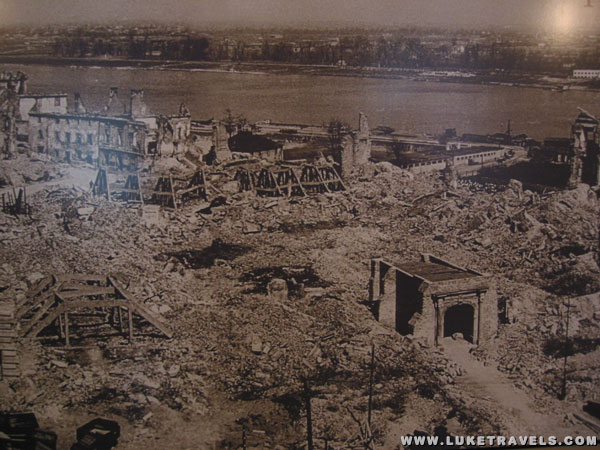
Warsaw's Royal Castle in ruins 1945
Although the
castle appears as a grand and well kept building from the outside, a
lot of technical and architectural improvements as well as a new air
conditioning system, electrical installation and roof tiles are
necessary. A ten year plan assumes investment of 200 million zloty (50
million US dollars).
 Warsaw Site Menu
Warsaw Site Menu
Warsaw Main Page |
Warsaw Photo Gallery
| Warsaw Facts |
Attractions and Sights |
Warsaw's Royal Castle |
History of Warsaw |
How to Get There - Air and Hotel Info
| Krakow Site
|
Auschwitz Site |
Contact Us | LukeTravels.com
Home
|
|



